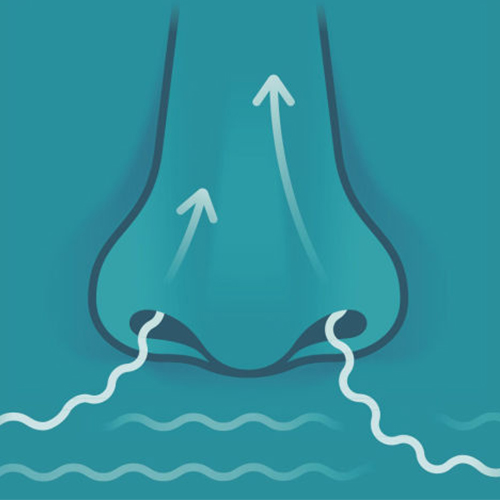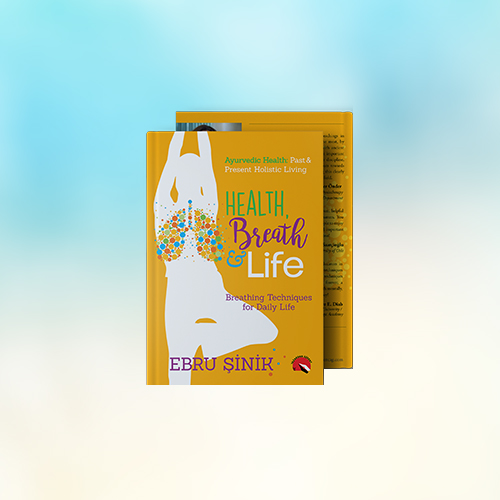What Do Ancient Sciences Say About Breath?
By Ebru Şinik - Wellbeing Instructor & Ayurveda Teacher and Holistic Health Author | Chopra Teacher
Before we look into the scientific findings of the Classic Western Medicine concerning the respiratory system and the methods of controlled breathing studies through the nose, we should take a look at the science of Yoga and Ayurveda breath and breathing techniques, which are 3,500 to 5,000 year old ancient and esoteric scripts that established the foundation of Vedic Knowledge.

5,000 year old ancient language of Sanskrit called breathing techniques “Pranayama”. “Prana” means ‘life force’ or ‘life energy’ and it is referred as the primary creative force of cosmos. According to Vedic Knowledge, Prana has many meanings; mind, vitality, essence of the creative awareness, where everything in the universe is created from Prana. “Yama” means specialization, becoming a master… and the combination of the two words “Pranayama” ultimately refers to ‘becoming an expert in the life force’.
Since the ancient times, people who have been in the path of enlightenment were aware that it was necessary to attain the highest level of consciousness in order to comprehend all aspects of life, universe, and cosmos. To reach that level, and to uncover different layers of the human existence, they meditated long hours in solitary. The ones who were advanced in meditation discovered that Prana was not only related to the physical body, it also exchanged energy and knowledge with mind and soul. It is written in Vedas that Prana actually acts as a bridge between consciousness and soul through breath, where breath is ‘within as a whole’ in all layers of life, and it is also a part of our environment that we live in, respiratory system, neural system, consciousness, and also in every single cell in our body. And accordingly, it suggests that controlling our breath will positively affect our physical, mental, emotional, and also psychological health.
According to Ayurveda, our mind, consciousness, and our breath are all mirrors of each other. Breathing insensibly without controlling our breath will result in depression, nervousness, tension, and aggression - as opposed to controlling our breathing will bring health and happiness, as well as cleaning our consciousness off of toxins. When breath freely circulates through our body and mind , we feel healthy and full of life. Yet when this life energy is blocked, exhaustion and sickness will start appearing.
When ancient breathing techniques called Pranayama are applied consciously; we can exchange our personal energy at physical and emotional levels without endeavoring with the energy of the universe by purifying the necessary channels, which helps us direct our life force in an evolutionary context that will allow us to reach high levels of physical and emotional well-being.
According to Upanishad, which is the ancient yoga scripts that explain the levels of Higher States Of Consciousness; is mentioned Existence Cycle as the physical, pranic, mental, and higher levels of consciousness. These layers exist as integral part of each other. Even though the human beings assume that these layers are separate from each other because of the inclination of a linear thinking other, they are indeed the intricate part of each other, and there is always an exchange of energy and knowledge between them. If mind tries to affect the physical body, it changes the flow of Prana. Yet if physical body tries to affect the mind, it changes the flow of energy. When there is a change in the flow of energy, the levels of vibrations will change first, and these vibrations combine to create a physical manifestation.
While uncontrolled and unconscious breathing would cause depression, nervousness, tension, and aggressiveness, controlled breathing will bring health and happiness, and also cleanses the consciousness out of the toxins. In order to explain Prana clearly, I would like to give an example. When a living creature dies, energy leaves its material body. Even though the physical body still exists as material, Prana, which we call life energy, leaves the physical body. In summary, according to the esoteric and ancient science, Prana; in other words, life energy, uses breath as a tool to enter physical bodies. Of course, this explanation is my filtered version of a very small summary. If you’d like to learn about the spiritual dimension of breath in depth, there are a few references in the back of this book, written by masters.
Before finishing this chapter, I would like to give you a few examples as to how the word ‘breath’ is used in different languages. I am hoping, with these examples, the dimensions of breath will be cleared in your minds.
In German “Atem” means “Breath”, “Atmen” means “Breathing”.
The word “Atman” from a 5000 year old Sanskrit is very important; the equivalent of this word in Turkish is “Can’’ which means Life, and in English is “Soul”.
“Soul ” and “Spirit ”2 are not the same things.
“Can (Soul)”, refers to the specific karmas, actions, desires, and memories, and it is an inseparable part of the “ Spirit ”.
For “Spirit”, which called “Brahman” in Sanskrit, used American Indians the phrase “Big Soul”.
When breath circulates in our body and mind freely, we feel healthy and full of life; and when the flow of this power of life is blocked, tiredness, and sickness will start appearing.

I am going to give a metaphor to explain these two concepts for a better understanding. Let’s assume that the ocean is “Spirit”. In this case, “Can (life) ” in Turkish, which is defined as “Soul” in English, and “Atman” in Sanskrit are the waves on the ocean. The waves are created by the ocean, and they hit the seashore, and go back to the ocean. In other words, a wave is born from Unified Consciousness, which is same as Spirit , and hits the seashore as Soul, an individual expression of “Spirit ”. Once it expresses itself on the shore, it returns to the Unified Consciousness, in other words goes back to the “Spirit”. I hope you understand the difference between “Soul” and “Spirit”, now?
For instance, when somebody dies, the word “expired” is used.
The word “expired” is a derivative of “Expiration”, which means “According to Dr. Mehmet Kasim, the President of Bilmen Academy that shares the teachings of Inayet KHan, Inayet KHan says that the soul is made of four parts. According to this, the word “Spirit” holds the first two parts of soul”, and the word “Soul” holds the last two partsAncient Turkish puts all four parts of soul into different words. These are “Oz (Can/Life), Oztozi, Yurek, and Tin.” The word “Tin” is the exact meaning of “Soul” in English. It also means “Rein”. In ancient Turkish culture, “Oz” means “Traveller”, “Oztozi” means “Driver”, “Yurek” means the place where “Oz” sits, and “Tin” means the reins of the mind and feelings. “Oztozi” should be holding the rein.
“Exhale”. Another meaning of “Expiration” is “the ending of the fixed period”. And also, in English, if a person’s mind is full of energy and creative, the word “inspired” is used. The other meaning of “inspired” is “Inhale” and it is used for “inspiration”, as its roots comes from Latin “Spirare”. Spirare means breath in latin, and the full meaning is, “the effect of God that follows right after him”. In English, there is also “Respiratory System”. In French, breathing means “Respirer”, in Italian “Respirare”, in Dutch “Ademen”, in German “Atmen”. It is not necessary to be a philologist to see that when languages were getting developed, many of the words in many languages derived “breath and breathing” from the meanings of the words “Spirit and Soul”, which is from one of the oldest languages of Sanskrit. The relationship is obvious… The words; breath, inhale, exhale are related to energy, life energy, creativity, which happen to be directly necessary needs to live.
We translate in Turkish “inspired” as “stimulated, sparked, uplifted”. So, where does this inspiration/stimulation come from? Ancient Knowledge says that the source of inspiration is “essence of self”.
Whatever word you’d like to use in your belief system, “essence of self” would be; Allah, God, Krishna, or energy as in the pure and eternal energy of the universe as an atheist. In other words, according to these esoteric explanations breath is the direct connection between us and the creator.
I’d like to repeat one more time; according to the esoteric knowledge, breath is a vehicle for life energy (Prana) to use to get into our body. After all these explanations, the science of inhale and exhale is more that just the movements of the chest and stomach as in expansion or contraction, it is related to the energy flow, and as to how this flow is hidden in the physical, conscious, and spiritual bodies.
 English
English
 Türkçe
Türkçe